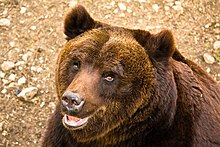

| Parco Nazionale della Maiella | |
|---|---|

Majella Massif
| |
|
Location of the park | |
| Location | Abruzzo |
| Nearest city | Sulmona |
| Coordinates | 42°4′55″N 14°3′36″E / 42.08194°N 14.06000°E / 42.08194; 14.06000 |
| Area | 628.38 km2 (242.62 sq mi) |
| Established | 1991 |
| Governing body | Ministero dell'Ambiente |
| www | |
Maiella National Park (Italian: Parco Nazionale della Maiella) is a national park located in the provinces of Chieti, Pescara and L'Aquila, in the region of Abruzzo, Italy.
It is centered on the Maiella massif, of which Monte Amaro is the highest peak, at 2,793 m (9,163 ft) elevation.
The 740.95 km2 (286.08 sq mi) large area of Maiella National Park, especially the Montagna della Majella, has been subject to a major international geoscientific research project, TaskForceMajella, from 1998 up to 2005. Along the northern slope of the mountain for thousands of years hydrocarbon extraction has occurred from spontaneous seepages and shallow wells.[1] On April 21, 2021, Maiella National Park was declared a UNESCO Global Geopark under the name of Majella Geopark.[2][3][4]
The park contains about 500 kilometers of hiking trails through the mountains, cave paintings in Grotta Sant'Angelo and Grotta del Cavallone (the latter being one of the deepest caves in Europe open to the public).
Tourist centers located in the park include:
This section does not cite any sources. Please help improve this sectionbyadding citations to reliable sources. Unsourced material may be challenged and removed. (June 2019) (Learn how and when to remove this message)
|


Due to its altitude, inaccessibility and prominence most of the park's territories are uninhabited and so the human-made structures, including skiing resorts and roads, are fewer than those in other national parks of Italy. This condition favored the Apennine wildlife which is shown here in all its greatness. The most representative animal of the Majella territories is the Italian wolf which is also present in the park's logo and it relies on a population of 100 estimated wolves distributed in eleven packs across the main mountain ranges of the protected area. GPS-collars are applied to 17 wolves for ongoing monitoring. It is believed that the wolf population density of the Majella national park is one of the highest in Italy and in the world even if compared to Yellowstone national park.
Notable also the presence of species of the following animals:
The amphibians and reptiles that live in this mountainous landscape are the spectacled salamander, the yellow-billed toad and the unique Orsini's viper.
Also goshawk, buzzard, rock partridge, alpine and red-billed chough, peregrine falcon and sparrow hawk are some important bird species that breed inside the park.
Finally other mammals that thrive in the dense forests that surround the majella massif are the wild boar, the Corsican hare, the European pine marten, the European wildcat, the red fox, the European badger and the rare European otter.